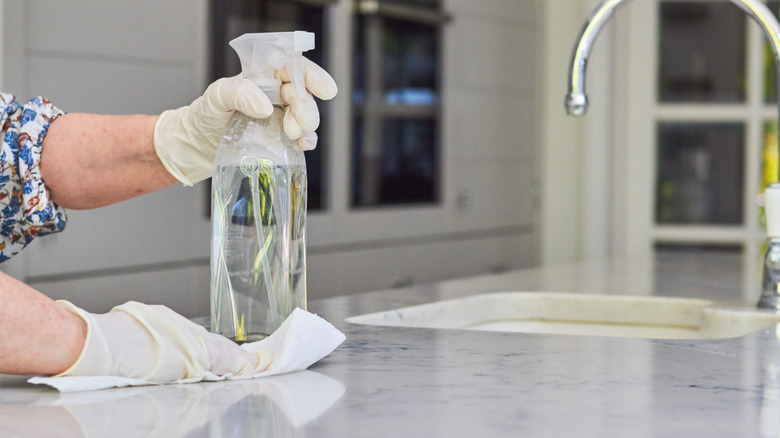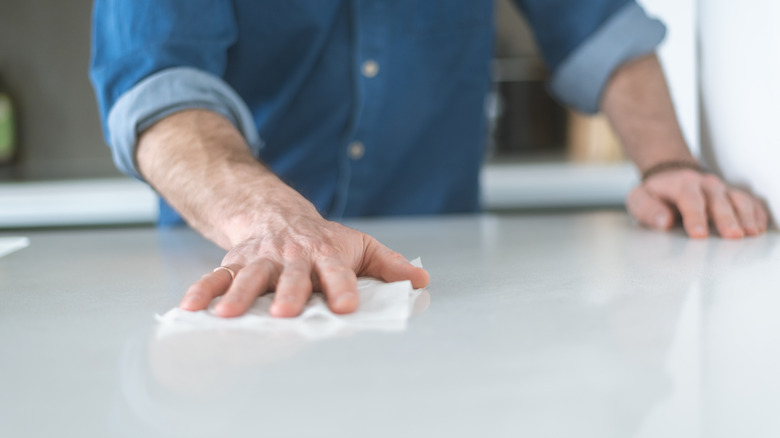Cleaning Quartzite Countertops Is Easier When You Have The Right Sealant
We may receive a commission on purchases made from links.
You may think that quartz and quartzite countertops are made from the same product, but they have a key distinction. Quartz is an engineered, non-porous material, and there's no need to seal a quartz countertop. Meanwhile, quartzite is a completely natural stone with a porous surface. The porosity means anything you spill seeps into the stone, resulting in stains. Cleaning these stains is a challenge if they're deep; you'll have to make a poultice, then wait for up to two days after applying it just to see if it lifts the stain. Sealing the quartzite with a quality sealant will keep spills from turning into stains, so all you have to do is wipe the countertop from time to time.
There are several types of quartzite sealants, including penetrating, enhancing, silicone, and topical sealants. All have their pros and cons, but penetrating sealants, like this Aqua Mix penetrating sealer, are generally the best option. These sealants go deep inside the stone's pores and coat them with a protective barrier that prevents liquids from making their way in. All the while, penetrating sealants have few effects on the natural aesthetic of quartzite. On the other hand, enhancing sealers coat the quartzite effectively, but give its surface an unnatural, moist look — so, they're an option if you don't mind altering the stone's innate appearance. Meanwhile, topical sealants provide a weaker protection that wears off quickly.
The steps for sealing your quartzite countertops vary depending on which product you choose, so follow the manufacturer's instructions for application. In particular, pay attention to the safety warnings on the product, since some sealants may give off toxic gasses during application. However, below we'll walk you through the typical steps for applying most penetrating sealant products.
Applying and cleaning a penetrating sealant
Start by cleaning the quartzite surface well until it's free of any stains. This process may take a while, especially if you have to apply a poultice to rid the stone of deep-seated stains. However, don't be tempted to take a half-hearted approach to the task — the last thing you want is to seal the countertop with stains still on it. Once you're satisfied that the countertop is clear of smears and debris, apply the sealant evenly across the entire surface (depending on the product, you may have to spray or pour it). Then, using a clean cloth, rub the sealant gently into the surface. The key here is to try and get the liquid into all the nooks and crannies of the countertop to create a continuous, impregnable seal.
Next, give the sealant time to bond to the surface. How long this takes varies depending on the product, but the optimal curing time should be stated on the product label. You may notice that the surface dries faster than the curing time on the label; in this case, you've applied too little sealant, and should add more of the liquid, repeating the same steps to work it into the countertop. When the liquid dries, repeat the same steps two more times, so you have a total of three sealant coats.
Now, perform the water test to check the quality of the new barrier. Simply pour a tiny amount of water onto the surface, and see if it turns into beads; if it does, then you're done. Once your quartzite is properly sealed, you can clean it daily with a simple all-purpose cleaner like the stain-proof daily countertop cleaner from DRY-TREAT on Amazon ($12.99) or even just with dish soap and water. This simple test tells you when it's time to reseal the countertop later down the road, too.

